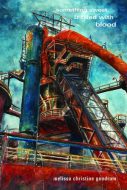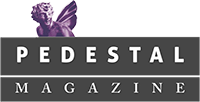 Melissa Christine Goodrum
Melissa Christine Goodrum
something sweet & filled with blood
great weather for MEDIA
Reviewer: Brian Fanelli
Poetry has always had a rich relationship and conversation with other art forms, and some of the most anthologized poems are ekphrastic poems, be it Keats’s “Ode to Grecian Urn” or Anne Sexton’s “The Starry Night.” The impact of the Armory Show in 1913 on William Carlos Williams was so profound that he mentioned it in his autobiography, and his mid-century essay/lecture “The Poem as a Field of Action” presented a manifesto regarding how poetry should be constructed and how poets should consider the use of the page and white space. In short, Williams referred to the subject matter of a poem as “its materials,” while adding that the poem is a space for “wish fulfillment.” As stated, the examples of poetry’s connection to other art forms, or linking visual art to poetic theory, are abundant, which brings us to something sweet & filled with blood by Melissa Christine Goodrum, a surreal collection that opens the poems up to multiple interpretations, while joining “word and image with the uncanny,” as Erica Hunt says in a blurb. The book is challenging at times, and it feels like stepping into a gallery of haunting, distinct, and, at times, disjointed images that correlate with wild leaps of imagination. The figures presented, be it a woman wrapped in cow skin, or a Cheshire’s head stapled to a wall, are not easily forgotten and will linger with the reader long after the final page.
The reader doesn’t necessarily need to know the various art to which these poems are responding. Goodrum’s lines are so taut and her visuals so precise that she creates a well-drawn and fully independent image for the reader. “oh, summer night” is a good example of what the reader is in for when tackling these poems.
this Madonna’s head
halos too red
she has one eye
over her right arm
& her night arm
is dead
she has red hair
(instead of brown)
& she’s holding
a vampire’s slick head
he’s drinking red tassels,
from an open leg
Edward’s eyes
emerge colorless
seeing this ‘i’ of sun.
& this drink
it is in his voice
The poem is a good representation of what’s at work in the deeply experimental book. There are uncanny images, for sure, including a Madonna’s head with red hair and red halos, thus challenging the traditional brown-haired image we usually associate with the figure, but then the poem makes an even greater leap, introducing Edward the vampire drinking red tassels from an open leg. This poem, among others, reminded me of Williams’s experimental work, namely Pictures from Bruegel or Spring and All, a period when his poetry responded to visual art and his line breaks, use of white space, and poetic theories reflected his association with artists. Williams had a way of lifting images off the page by writing short, tight lines, often isolating images or colors to separate lines, surrounding them by white space so they had a greater impact and caused the reader to pause and linger on each image at a time before the poet made a leap or juxtaposition. In a way, Goodrum is doing something similar with this poem, often introducing one image per line, before moving on to an even more bizarre image and fleshing out the complete visual. We start with the broad image of the Madonna’s head in the opening line, before the second line presents the red halos, and then the rest of the first stanza focuses on her arm and eye. Line by line, the poet builds to a larger image, making each part so distinct for the reader that the images and colors float off the page.
A few poems are straightforward in their intent and narrative, and they serve as an effective pause from the experimentation. “morning lights” echoes the idea that anything can serve as subject matter for poetry and that there is beauty in the everyday; in this case, the sounds and sights brought forth by morning light.
I close my tired eyes
warm under the sun
and the loon, she awakens
stirs & stretches
out her golden mane
on miles of grasslands
that sleep like the Sahara
so I take a large breath in
to remember
the hot sun sweeping
open my eyes,
& let my feet roam.
The poem itself, void of punctuation, other than a comma/caesura in the third line and a final end-stopped line/period, feels like one long breath, thus mirroring some of the poem’s content. Even when describing a familiar image, in this case the morning light and a loon, Goodrum does it with such a distinct eye that it becomes like a painting, showcasing the loon’s golden mane and the hot sun sweeping open the speaker’s eyes. It’s a 12-line poem painted with stark color and engaging visuals.
In “& Penelope waits—the annals of a patient woman,” Goodrum writes in response to Homer’s character, the wife of Odysseus, who had to ward off suitor after suitor. In this take, we finally hear Penelope’s voice and the longing that comes from waiting and waiting for a lover to return. Again, Goodrum gives us specific detail, so that we empathize with Penelope’s pain, especially when she returns home after dealing with the suitors only to find her husband’s chair empty and the fire ash untended. Her unshed tears are stacked “like silk shifting underneath her surface,” and the longing is compounded as she recalls Odysseus’s “tall wounded body,” “his scratchy suntanned face,” and “the rough touch & feel / of him & working hands.” The poem ends with Penelope still waiting while dreaming of Odysseus dancing towards home, but there is much to be said for a poem written in Penelope’s voice, underscoring both her heartache and faithfulness, especially as her role in Homer’s epic is brief, mainly limited to the final act and Odysseus’s return to Ithaca and battle with the suitors.
In an interview with The Nervous Breakdown from this year, Goodrum stated that she is drawn to literature and art that give the reader or audience member some control: “I’ve always loved reading, because the best authors allow the reader to retain creative control of so many of the details within the narrative. I can hear the tonalities in the characters’ voices, visualize the descriptions of the settings and actions anyway I want to see them, and fill in the blanks using my imagination. The same is true for many of the visual arts. When I stand in front of a statue, I imagine what happened in the moment just before or after creation.” The appeal of ekphrastic poetry, she added, is that it allows her to continue the narrative constructed by the artist, while making something new. This is indeed the balance struck in something sweet & filled with blood.

